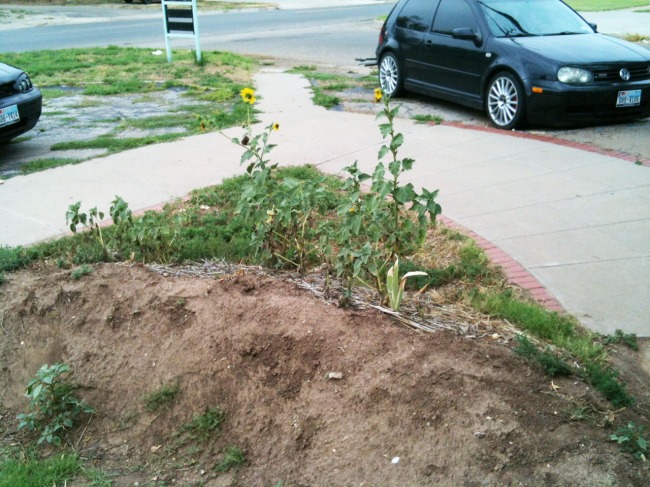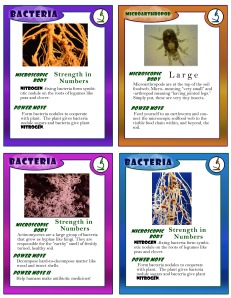This year the High Plains Food Bank hired me to teach nutrition, gardening, and put in a garden at the Mavrick Boy’s and Girls Club. Please feel free to use the lesson plans I put together; Here are 1-3 of 9 lessons for the summer. The visuals are in separate posts. The lessons teach K-5th grade of kids about Permaculture Principles.
Week 1
Catch and Store Energy
Open Exercise: Based on Observe and Interact: We sit in a circle on the ground. We go around the circle practicing ‘active listening’ and each student observes something on the ground in the circle.
Walk around Garden: As students walk around explain for the next three weeks/classes we will be getting garden points for observing and interacting with the garden. Refer to garden point chart.
Objective: Plants catch and store the sun’s energy in their bodies. People and animals use the energy stored in plants.
Many students already understand plant leaves create food from sunshine. The more leaves we have, the more sunshine they catch, the more energy available to animals and people. Our society talks a lot about saving energy, in terms or electricity – turning off lights, in terms or gas – getting better gas mileage. Forms of energy like gas and coal (where most of electricity in Amarillo, Texas region comes from) are fossil fuels, ancient deposits of material that we burn to ‘make’ energy. The sun rises every morning. Plants turn the sun into food, building material, cloths, and more. How can we use plants to catch the most energy? We can plant plants in an area, for a long time, densely. Forest Gardening is one way to plant an area, densely, with perennial plants to last a long time (100s of years). Garden like the forest with layers of vegetation: tall trees, low trees, shrubs, herbs, ground cover, and vines.
Activity 1: Show the students the energy flow tetrahedron. Explain area like a row of plants (ie tomatoes), then time as the plants grow more leaves with more time, explain density by adding basil between the tomatoes in a row. Area x Time x Density. Now use rope and signs to have the kids make the energy triangle with labeled lines. Have them imagine whatever plant they choose in the triangle with all the leaves catching the sun.
Activity 2: Game: Sun Beams and Plants
Talk about the basil between the tomatoes and say forests grew because a forest knows how to capture the maximum amount of sun. How? Let us hold up the signs: tall trees, low trees, shrubs, herbs, ground cover, and vines. Tall and short plants, climbing vines make sure to catch as much sun before it hits the ground. We are going to play Sun Beams and Plants, (Sharks and minnows). The first plant picks a sign to wear and each time someone joins the plant side the player picks a sign to wear until everyone is caught and we declare ourselves a ‘Forest Garden’ that catches all the sun beams.
Close: Have students form six layers of forest garden together with their bodies and/or holding signs. What are the plants catching? (Teacher pretend to send sunbeams) Sun! to what? Turn into energy for people and animals.
* Points: students can take Forest Garden Layer Color Sheet 1 or 2 to completely color and bring back for 20 garden points. They can turn in garden box at front desk whenever ready.
Week 2
Obtain a Yield
Open Exercise: Based on Observe and Interact: We sit in a circle and remember observing things on the ground, this time we observe what is above and outside of circle. We go around the circle practicing ‘active listening’ and each student observes something while everyone else listens until their turn.
Walk around Garden: As students walk around explain for this is second class observing and interacting with the garden for garden points. Refer to garden point chart. Point out medicinal plants: mint is good for rehydration, lavender calms anxiousness, rosemary helps focus. Point out fertilizer and cover crops and dynamic accumulators: lambs quarter, buckwheat, clover. Admire a beautiful flower.
Objective: As gardeners we want to grow plants that produce the 7 Fs: food, fuel, fiber, fodder, fertilizer, ‘farmaceuticals,’ and fun.
We talked about plants turning sunshine into energy. As gardeners we want to harvest energy to stay alive. The more energy we help useful plants capture the more we can be healthy and happy. Gardeners that can grow a large harvest and use it wisely can meet the needs of themselves and others. Many human needs can be met by established gardens, remember time, area, density. People can use the sun’s stored energy as the 7 Fs: food to eat; fuel like for a campfire or bio fuel for cars; fiber for our cloths and rope; fodder means animal food; fertilizer because some plants help other plants grow; farmaceuticals (really starts with ph) plants can be our medicine; and fun as flowers for decoration, trees to climb, and dyes to color our lives.
Activity 1: Song
Words Motions
– Food to feed our body and minds (strong arms and then point to head)
– Fuel to heat, light, and run our lives (rub hands, point up, running arms)
– Fiber to cloth and tie (pop collar, tie shoe)
– Fodder food for animals (put bull horns on and shake head with each syllable)
– Fertilizer to help our plants grow (with partner: one waters one grows)
– Farmaceuticals plants as medicine (hold hand on forehead, eat leaf, remove hand, and smile)
– Fun! Plants to enjoy and play (smell flower, act like swinging in tree)
Activity 2: Scavenger Hunt
Students have 7 minutes or whatever time, to search around garden and outside garden to gather something to represent food, fuel, fiber, fodder, fertilizer, farmaceuticals, and fun. Offer help and help students when they need it to identify plants mentioned in garden walk.
Close: Name the 7 Fs.
*Points: students can bring bag with plants from home representing 7 Fs for 20 garden points.
Week 3
Apply Self-Regulation and Accept Feedback
Open Exercise: Based on Observe and Interact. We go around the circle practicing ‘active listening.’ Each student makes a noise of what they feel like. Then we have 10 seconds to each find a place by ourselves to observe and interact in silence for 2 minutes.
Walk Around Garden: Notice how things have grown since we first started, taste things, measure with hands. Notice positive, ie growth, negative, ie bugs or smelly compost. Refer to garden point chart.
Objective: A Feedback loop gives information for us to make decisions now and for the future.
What is feedback? Some people think of it as complement, judgment, or criticism; ie “What did you think of my song?” “It was strong and beautiful,” “it was out of key,” “I didn’t like it.” Well from those responses, or feedback, we will make decisions on singing again, correcting the tuning, or not singing for that person again. Feedback loops are when information from the past or present help us make decisions about the present and future. Last time we talked about the 7 Fs; these are positive feedbacks that appear when we are gardening well. Negative feedbacks are sometimes slow to show up; ie we don’t drink water all day and by night we have a headache, feel tired, and are hot, we are dehydrated, but it takes a while to figure out. Ancient cultures warned about negative feedback loops: The sins of the fathers are visited on the children unto the seventh generation.
Activity 1: Watch Story of Stuff on Internet
Introduce movie as Story of Stuff and say after movie will compare what we can potentially get out of our garden with compared to production shown in movie. The feedback loop good or bad is a small one we can quickly see in the garden, and a large one that is difficult to see from the goods coming from far away like in the freight trains next to our garden.
Activity 2: Swing Rope Around and kids jump over it.
Our bodies are one of the most important tools to read feedback loops. Our five senses can observe and interact like we do in the garden. Our bodies have many systems to sort through information: when we are sick we need to look back something in our environment that is sick. As the rope circles around we want to jump over it. We are paying attention to the fast or slow moving thing and we will jump fast or slow in response.
Close: What word did we learn today? Feedback loop! What does a feedback loop help us do? Make decisions.
Points: non for this week, can pick up trash at end of class for Mavrick Bucks.
 The Southwest Corner of BikeLife surrounded by asphalt parking lot and cement is a tough place to grow plants. The sunflower and iris are crisply hanging on with a little supplemental water. The Amarillo, Texas winds prevail from the SW. We get hail storms, high winds, over 100 degree days and hard freezes.
The Southwest Corner of BikeLife surrounded by asphalt parking lot and cement is a tough place to grow plants. The sunflower and iris are crisply hanging on with a little supplemental water. The Amarillo, Texas winds prevail from the SW. We get hail storms, high winds, over 100 degree days and hard freezes. Mountain Mahogany was suggested to me by http://wichitapermaculture.com/. Mountian Mahogany is a nitrogen fixer, nectar source April -June, drought tolerant, and slow growing. Deer like to browse the leaves, so potentially it could supplement any browsing animals diet. Also it comes back from the roots even when harshly pruned, burned, or topped. Its gnarly appearance, slow growth rate, drought tolerance, and suckering from the roots make it a good choice for our front. With regional growing interest in xeriscape this is a great showcase corner, and people can propagate new trees from the suckers.
Mountain Mahogany was suggested to me by http://wichitapermaculture.com/. Mountian Mahogany is a nitrogen fixer, nectar source April -June, drought tolerant, and slow growing. Deer like to browse the leaves, so potentially it could supplement any browsing animals diet. Also it comes back from the roots even when harshly pruned, burned, or topped. Its gnarly appearance, slow growth rate, drought tolerance, and suckering from the roots make it a good choice for our front. With regional growing interest in xeriscape this is a great showcase corner, and people can propagate new trees from the suckers.






